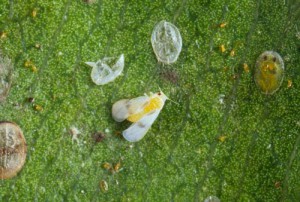 Weeping fig Ficus benjamina hedges are a common sight in the Florida Keys. If you have one in your landscape, it’s a good idea to inspect it for possible infestation by a new pest first found in the U.S. in 2007. The ficus whitefly Singhiella simplex can severely defoliate ficus hedges. Although the main species affected is the benjamina, other figssuch as the banyan may also have infestations.
Weeping fig Ficus benjamina hedges are a common sight in the Florida Keys. If you have one in your landscape, it’s a good idea to inspect it for possible infestation by a new pest first found in the U.S. in 2007. The ficus whitefly Singhiella simplex can severely defoliate ficus hedges. Although the main species affected is the benjamina, other figssuch as the banyan may also have infestations.
The adult whitefly has a yellow body and white wings with a faint gray band. Nymphs are tiny tan to light green flat ovals with red eyes. They are immobile and can be found on the underside of leaves sucking the leaf juices and causing the leaf drop.
This pest is easier to manage when detected early, as it takes several generations to reach a population high enough to cause major damage. The first signs of an infestation are leaves that wilt, turn yellow, and drop. If you disturb the foliage, a cloud of small white gnat-sized flies will appear. You may see small silvery spots on the undersides of the leaves, which are actually discarded skins.
If you find an infestation of whiteflies in your ficus, prevent spreading the problem by leaving any trimmings on your property or bag them before disposal.
There are several natural predators (including beetles, parasitoids, and lacewings) that help keep this pest under control. It is important that management practices for the whitefly do not destroy these natural enemies.
If your plant has lost its leaves, wait until it shows new growth before using any pesticides. Be careful not to over water it. New growth on small trees or shrubs can be treated with insecticidal soap or horticultural oil. Spray late in the day, cover the underside of the leaves thoroughly, and repeat every 7 to 10 days.
Systemic soil drenches protect new growth and last longer but cannot be used near water. Products containing a neonicotinoid compound are recommended and are listed in the first publication below. Continue to monitor your plants and use a foliar spray on any hotspots that develop.
If damage is severe, consider replacing your hedge.
For more information:
http://miami-dade.ifas.ufl.edu/pdfs/urban_hort/Ornamental%20plants%20commonly%20used%20as%20hedges%20in%20south%20florida.pdf
These links were updated in March, 2013.
 0
0
